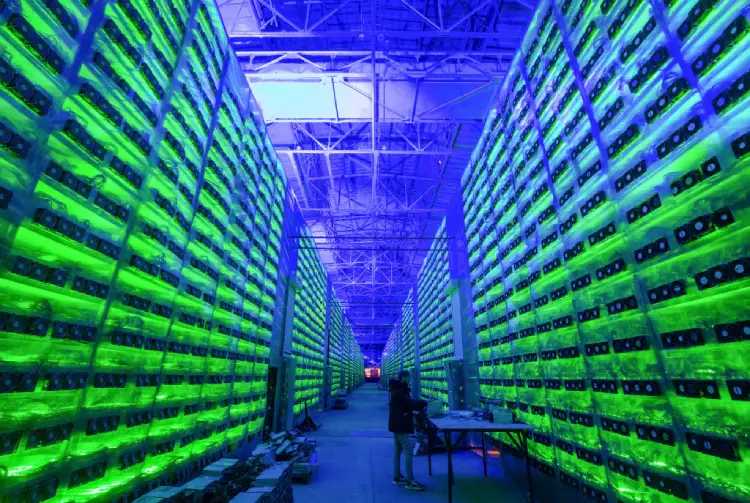
The technology industry is under increasing pressure to reduce its carbon emissions. It currently accounts for 2% to 3% of global emissions, according to the UN, but as more of the world comes online and digital technology permeates all aspects of life, that figure could grow rapidly if left unchecked.
Analysis of the carbon disclosure by 30 of the world’s largest tech companies by Tech Monitor reveals mixed progress, with many technology providers struggling to contain their Scope 3 emissions.

Tech Monitor analysed emissions data from 30 technology companies representing a cross-section of the industry, from telecommunication giants to cloud computing providers. The data was collected from various annual corporate responsibility reports from 2017 to 2021 by business intelligence provider GlobalData.
The analysis reveals that while Western telecommunications companies have generally succeeded in shrinking their carbon footprint, cloud providers including Microsoft have seen an increase in emissions as their business has grown.
Tech industry carbon emissions: most improved companies
Among the 30 companies analysed, Japanese technology giant Toshiba and IT services provider Accenture have achieved their greatest proportional decreases in carbon emissions since 2017. Both companies have reduced their total carbon emissions - including Scope 1 and 2 emissions (those that derive from its own operation) and Scope 3 (produced by the company's broader value chain, including suppliers and customers) - by 64% in that time.
Accenture has committed to achieving net-zero carbon emissions by 2025. Just over half (53%) of its office energy needs are currently met with renewable energy, the company says, and it aims to reach 100% by next year. The company also plans to require all of its suppliers, a key contributor to Scope 3 emissions, to disclose their environmental targets and decarbonisation plans by 2025; 58% have done so already, Accenture says.
UK telco Vodafone is among the best performers in terms of proportional carbon reduction, having cut its Scope 1-3 emissions by 26% since 2017.
This reflects the company's commitment to energy efficiency and renewable electricity, a spokesperson told Tech Monitor. “Our base stations and data centres account for almost all of our energy consumption,” they said. “So we have invested in energy efficiency and on-site renewables in addition to deploying more efficient network equipment and gradually switching off the less-efficient 3G network.”
Vodafone also uses AI in its passive infrastructure to optimise its energy use. The company has implemented an energy data management system from eSight Energy that monitors data feeds from electricity suppliers and smart meters in 62,000 sites across Europe.
Despite these reductions, Vodafone is still among the largest carbon emitters in the group, having produced 10 million tonnes of CO2 in 2021, according to its latest report. The company plans to “eliminate all carbon emissions” from Scope 1 and 2 categories by 2030, and to remove all Scope 3 emissions by 2040.
Telecommunications giant BT Group has managed to cut its total emissions by 20% in the past five years, from approximately 4.5 million tonnes in 2017 to 3.6 million at the end of last year.
“Since 2016, BT has reduced the carbon emissions intensity of its operations by 57% and by 19% across its supply chain,” says Richard Marsh, sustainability strategy director at BT. “And over the last decade, we’ve seen our annual energy consumption reduce year on year and we now use 100% renewable electricity worldwide.”
Marsh adds that BT has implemented plans to bring forward the company’s net zero target from 2045 to 2030 for its operational emissions, and to 2040 for supply chain and customer emissions. The company is now leveraging its technological expertise to assist other smaller companies in their environmental reduction goals, he says.
In absolute terms, Japanese manufacturing giant Hitachi made the biggest cut in its carbon emissions out of the companies analysed, reducing its total emissions by a staggering 51.5m tonnes between 2017 and 2021. Hitachi has committed to net zero emissions from its own operations by 2030, and from its entire value chain by 2050.
The tech industry's worst performers
Other technology providers have struggled to contain their carbon emissions, however. The worst offenders in the group, in terms of proportional change, are Indian telco Bharti Airtel, whose emissions have grown 86% since 2017, and IT services provider Wipro, whose carbon output grew by 85%. (Both companies' emissions are relatively small in absolute terms, at less than 100,000 tonnes per year.)
Software and cloud giant Oracle's emissions have grown 63% since 2017 across Scopes 1, 2 and 3. A spokesperson for the company said this increase is explained by the fact that its 2017 Scope 3 emissions data is incomplete. Scope 3 data for subsequent years provide "a more accurate picture of Oracle’s footprint”.
“Our global carbon footprint has dropped by 10% and we expect to achieve significant reductions in the coming years as we increase the precision of our calculations and continue to work closely with our key suppliers,” the spokesperson said.
“Oracle is committed to powering its global operations using 100% renewable energy by 2025, and last year we set a net zero target for 2050," they said, adding that this includes a plan to halve Scope 1, 2 and 3 emissions by 2030.
Microsoft has struggled to contain its collective emissions against a backdrop of booming growth, the data reveals. Its total emissions across Scope 1, 2 and 3 have grown 29% since 2017, reaching 14 million tonnes of CO2, the highest it has ever been in the last five years.
In a blog post published last month, the company’s president Brad Smith and chief environmental officer Lucas Joppa acknowledged its Scope 3 emissions are “the most difficult to control and reduce”. In 2021, these accounted for 98% of Microsoft's total carbon footprint.
The executives attributed the expanding emissions to “significant business growth” in 2021, in which the company’s revenue grew by 20%. This was largely due to an increased demand for its Azure cloud offering, as well as massive growth in sales for the Xbox gaming console and its collective usage at the height of the pandemic.
It seems unlikely that Microsoft will be able to reduce its emissions in the near future. It currently operates more than 200 data centres across 34 countries and "is on pace to build between 50 and 100 new data centres each year for the foreseeable future," it said in a blog post last year.
Smith and Joppa wrote that Microsoft's experience with increasing emissions provided “critical and additional early learning” towards Microsoft’s carbon negative plans by 2030. Those lessons are being applied to “strengthen efforts to reduce our Scope 3 emissions”.
In absolute terms, network equipment maker Cisco has witnessed the steepest increase in emissions since 2017, with a 17.7 million tonne increase. This again reflects the challenges of reducing Scope 3 emissions, which make up 99% of the company's emissions.
How can the tech industry further reduce its carbon emissions?
Reducing Scope 3 emissions is the tech industry's greatest decarbonisation challenge, says Laura Tedeschi, ICT sector lead at Carbon Trust. "Scope 3 emissions are emissions companies can influence, but don’t have any direct control over," she explains.
While many tech companies have been able to cut their own emissions by switching to renewable energy sources, they often have “carbon hotspots” in Scope 3, says Tedeschi. These might include the materials and services they buy, capital goods such as manufacturing equipment, or the use of their products by customers once they have been sold, according to Tedeschi.
Tech companies can get a better handle on their Scope 3 emissions by refining their calculation methodology, Tedeschi argues, for example by counting all goods and services purchased and their individual footprint.
This will get easier as more companies report their direct emissions. “All value chains are linked in some way, so one company’s Scope 1 and 2 emissions are someone else’s Scope 3,” Tedeschi explains.
“Supplier engagement is another key aspect related to reducing Scope 3 emissions to be able to collect product-specific data and to develop reductions initiatives across the value chain,” she adds. “So collaboration across the sector and product innovation right from an early stage is the only way to solve these industry-wide issues."






